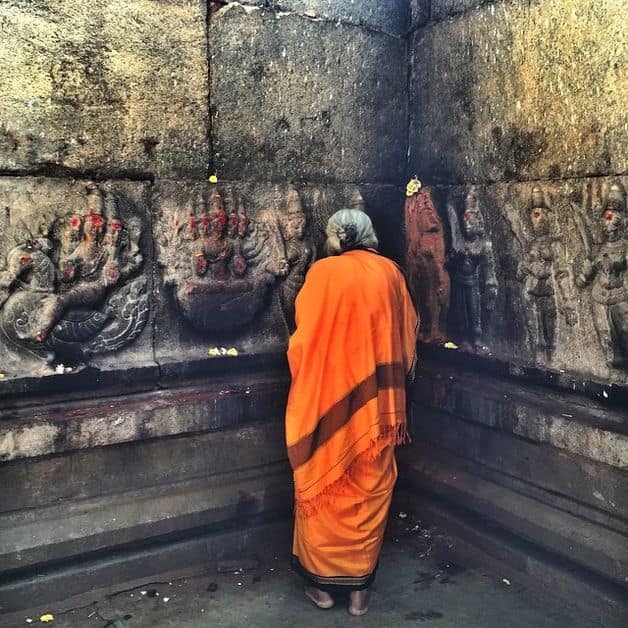About the Kodali Karuppur Saree
5 min read .
The first time I saw a Kodali Karuppur sari was on Geetha Rao, a textile expert. I met Geetha at the Bangalore Black Tie, where a group of foodies pay to have a structured tasting with paired wines at some of the city’s best restaurants. Geetha’s husband, S.L. Rao, is a renowned economist, but I usually gravitate towards her, mostly because of her lovely saris.
There are women like this everywhere in India. You see them at weddings and events, looking impeccable in their crisp elegant weaves: Ilkal, Tussar, Maheshwari, Jamdani, Kanjeevaram, Venkatagiri, Chanderi, Paithani, or Baluchari. Even the names are so poetic; imagine the product.
Growing up in Chennai, I used to look up at the mother of my close friend, Deepika Radhakrishna, in this way. Sabita aunty—as we called her—ran a boutique called Amrapali. She dressed with flair—usually in a stunning sari with a big red bindi. Visiting her home was like visiting a fashion show: models coming in and out, rolls of textiles with kalamkari and other prints, and Sabita aunty’s hand-drawn designs on what appeared to be wax paper. After my friend passed away, Sabita aunty went on to write two cookbooks, including the award-winning Aharam. But she still retains her passion for Indian textiles.
The garment of my childhood certainly was the sari. All the women I looked up to wore them with style and elegance. There was Prabha Narasimhan, who now runs a Chennai boutique called Amrita. She used to work at Sita Travels and sold me my first airline ticket to America. When she learnt that I was going to cold Boston, she gave me—an unknown, anonymous student—her embroidered Kashmiri overcoat, and explained the finer points of its weave to me. I am sure she has forgotten the gawky student who bought a ticket from her. I haven’t forgotten the lady who gave me my first overcoat. Dancer Anita Ratnam used to appear at the Music Academy wearing stunning jewellery, and unusual saris. On stage sat M.S. Subbulakshmi in her parrot-green Kanjeevaram, her eyes half-closed as she sang to the divine—in bliss.
Finally, we come to the sari that caught my attention.
Kodali Karuppur is a place near Trichy in Tamil Nadu. According to an article in the Craft Revival Quarterly, these saris flourished under the patronage of the Maratha rulers, who were so taken by the combination of techniques used that they gifted these textiles as part of their khillat, or dresses of honour. The techniques used are—get this— wax-resist hand painting, block printing and intricate weaving. First the weaver weaves the sari using brocade fabric, sometimes with silk thread mixed with the cotton thread. Then he uses block prints on the sari with the block-printed butas or motifs matching exactly with the brocade butas, to give what Reena Agarwal, the author of the article, calls a “tinsel-patterned” effect. Got that? I think what this means is that you have to painstakingly place the printing block exactly over the buta or motif of the brocade so there is no overlap. Now, on top of all this, you do this whole wax-resist thing. Basically, the craftsman paints a design like a floral motif, covers the rest with wax, dyes the fabric using natural dyes that give a rich red tone to the pallu of the sari, and then removes the wax to reveal the background design. At least, that’s what I think.
You know, at this point, I have to throw up my hands and admit defeat. All these techniques are above me and I don’t fully understand them. If you are a textile buff as I am, please visit the Craftrevival.org website and read about the process of production. Better yet, visit the Calico Museum in Ahmedabad where an antique Karuppur sari hangs in full splendour.
There are so many layers to this particular sari that you probably think the final product will be gaudy. It isn’t. Take my word for it.
Shoba Narayan is at Bangalore’s Dastkar Nature Bazaar this weekend, searching for Kodali Karuppur saris, Malkha, and other unusual fabrics. The Dastkar Nature Bazaar is on at the Bangalore Palace grounds till 15 August. Write to her at [email protected]
Updated: 05 Aug 2010, 10:35 PM IST






I just loved reading about your love on sarees..
Beautiful write up from a Sari lover!!!The details of what goes around making the final product is totally awesome ??
As someone born & raised in Trichy it gave me a sense of pride to read about this…I used to visit a friend in Woraiyur, near the Panchavarnaswami temple where a few streets had lots of teaspoons washers living in them, with three looms in the front loom. Even now I can hear the sounds of the looms like a distant train. Can’t say that I have heard about this particular saree, though.
Thanks for bringing back some nostalgic memories. Brilliant write up.
Sorry, not teaspoon washers, but traditional weavers ?
Thank you so much. I must visit Woraiyur.
Loved it! I also write about different sarees and art forms from India. I would like to connect and share those with you!